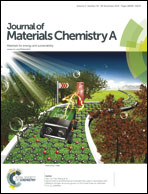Microwave-assisted growth of In2O3 nanoparticles on WO3 nanoplates to improve H2S-sensing performance
Abstract
Hierarchical In2O3@WO3 nanocomposites, consisting of discrete In2O3 nanoparticles (NPs) on single-crystal WO3 nanoplates, were synthesized via a novel microwave-assisted growth of In2O3 NPs on the surfaces of WO3 nanoplates that were derived through an intercalation and topochemical-conversion route. The techniques of XRD, SEM, TEM and XPS were used to characterize the samples obtained. The gas-sensing properties of In2O3@WO3 nanocomposites, together with WO3 nanoplates and In2O3 nanoparticles, were comparatively investigated using inorganic gases and organic vapors as the target substances, with an emphasis on H2S-sensing performance under low concentrations (0.5–10 ppm) at 100–250 °C. The results show that the In2O3 NPs with a size range of 12–20 nm are uniformly anchored on the surfaces of the WO3 nanoplates. The amounts of the In2O3 NPs can be controlled by changing the In3+ concentrations in their growth precursors. The In2O3@WO3 (In/W = 0.8) sample has highest H2S-sensing performance operating at 150 °C; its response to 10 ppm H2S is as high as 143, 4 times higher than that of WO3 nanoplates and 13 times that of In2O3 nanocrystals. However, the responses of the In2O3@WO3 sensors are less than 13 upon exposure to 100 ppm of CO, SO2, H2, CH4 and organic vapors, operating at 100–150 °C. The improvement in response and selectivity of the In2O3@WO3 sensors upon exposure to H2S molecules can be attributed to the synergistic effect of In2O3 NPs and WO3 nanoplates, hierarchical microstructures and multifunctional interfaces.


 Please wait while we load your content...
Please wait while we load your content...